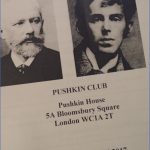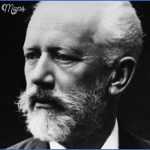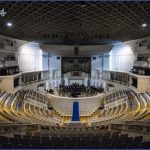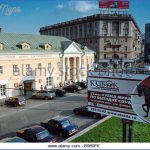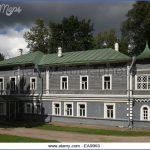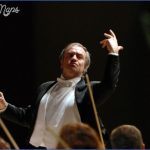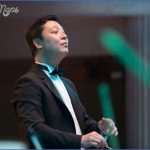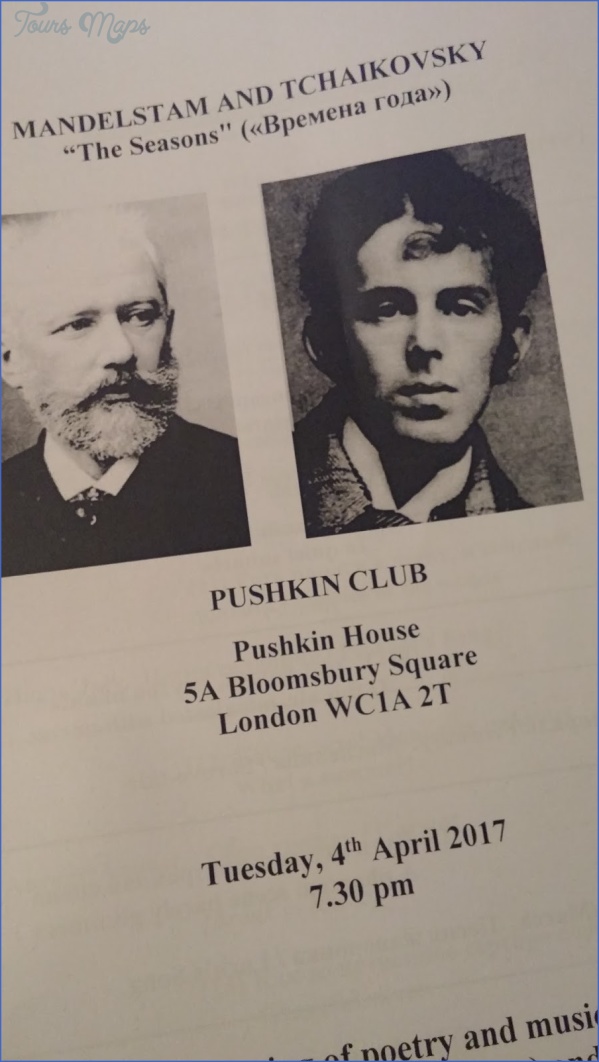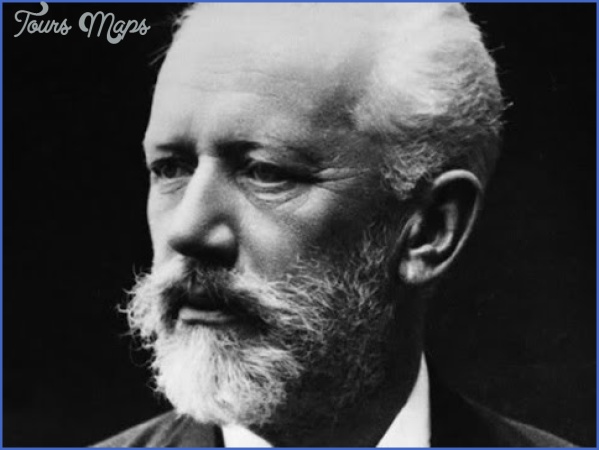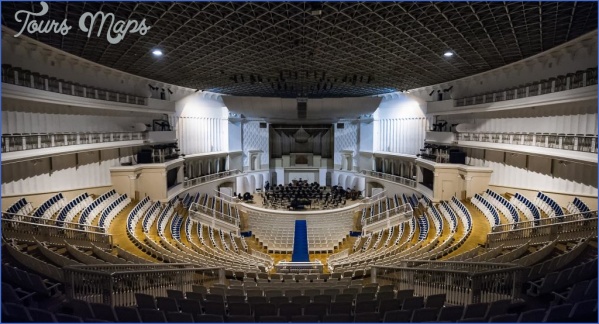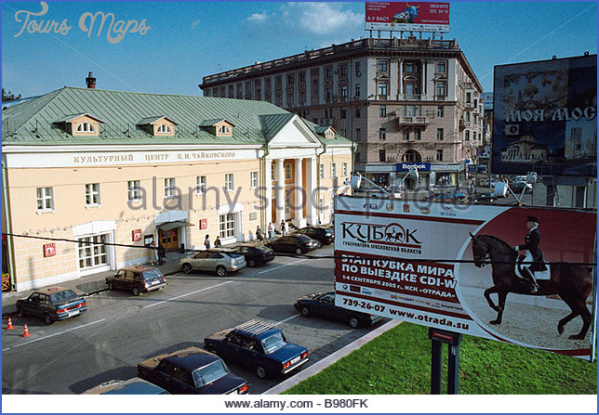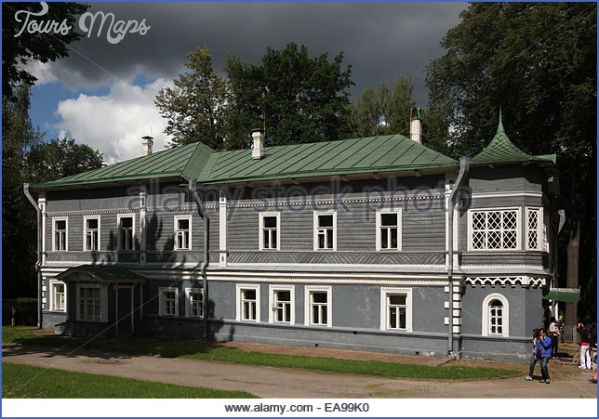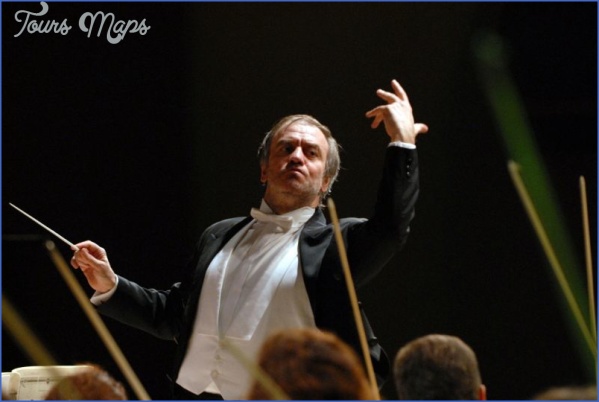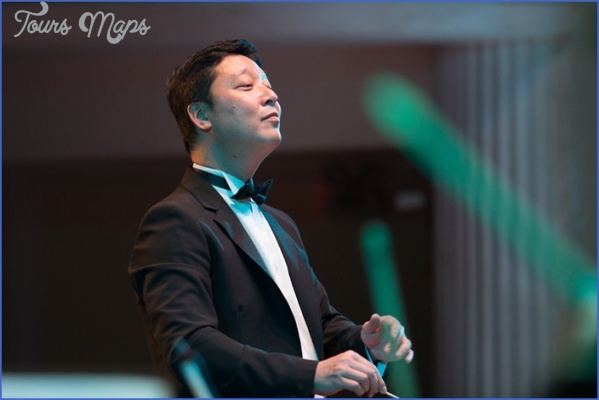Tchaikovsky Cultural Centre
TCHAIKOVSKY MUSEUM
The way of the pilgrim to the Tchaikovsky shrines is not an easy one. Allowance must be made for the weather, the paucity of English speakers, the great distances and the often seemingly insurmountable difficulties of travel in Russia and Ukraine. Ironically, there is no museum honouring him in either St Petersburg (where he was educated, where many of his works were first heard and where he died) or Moscow (where he taught), although the conservatory and the hall that is home to the State Symphony Orchestra there bear his name as too does the conservatory in Kiev. From 2005 there will be a Tchaikovsky Cultural Centre in the building in which he occupied a second-floor flat, with memorial rooms reconstructed and furnished in 19th-century style and concert and exhibition halls on other floors. There are hopes for a museum in his brother Modest Tchaikovsky’s flat in St Petersburg in which he died, now privately owned (though you may dine in the restaurant beneath it). He is not commemorated in any of the cities elsewhere in Europe to which he travelled. Shy, and of nervous disposition, he preferred rural settings for his creative work, cocooned by family, a small circle of friends and his faithful retainers, to the cities where his music was performed. Until recently Votkinsk, where he was born, has been a closed city because intercontinental ballistic missiles were manufactured there during the Cold War period, in factories including the one managed by Tchaikovsky’s father, Kamsko-Votkinsky Zavod (in his day it produced cannons, anchors and bridges). Reached by flying to the Udmurtian capital, Izhevsk, Votkinsk is a further The Tchaikovsky museum at Votkinsk 60 km to the north-west, some 1000 km east of Moscow, close to the foothills of the Ural Mountains; it lies at the junction of two rivers, dammed at the command of Peter the Great to generate power, and also creating what is now an attractive lake.
The Tchaikovsky family lived in the factory manager’s house, by the lakeside, which also served as the headquarters of the mining district that provided the raw materials for the factory. Designed by an architect from St Petersburg and built in 1806 of wood made to look like stone, in the style of a St Petersburg mansion, it is the central building of a complex that today includes a concert hall (recently refurbished with a grant from the Soros Foundation), a cafe, a shop and a boarding house for overnight visitors as well as buildings for the factory and museum archives, summer and winter garden houses, and what was formerly a bathhouse, along with accommodation for serfs and stabling – all now open to the public and displaying 19th-century domestic crafts. Between the house and the water is a large statue of the composer on a platform, where visiting musicians perform during the summer.
Tchaikovsky’s father, Il’ya Petrovich, arrived in Votkinsk in 1837, ahead of his wife, to take up his job as factory manager and to ensure that the house for his family was comfortable and welcoming. Having spent most of his life in the region, where he had previously served as a draughtsman’s apprentice, he was already known and well liked. Both husband and wife were educated people and their home quickly became a local centre of culture. Tchaikovsky senior ran the factory, which employed 3000 men, for eleven years. During that time four children, including Pyotr Il’yich, were born, supposedly in a room at the front of the house; outside, at the extreme right corner of the front, there is a plaque commemorating the composer’s birth on 7 May 1840.
Tchaikovsky Cultural Centre Photo Gallery
This spacious, two-storey house on the lakeshore also accommodated Il’ya Tchaikovsky’s daughter from his first marriage, two nieces who had lost their parents, an elderly aunt and a governess. Unique among composer museums, the birthplace offers visitors a tour of the eleven principal rooms in which members of the museum staff, in costume, take the roles of Tchaikovsky’s parents, his piano teacher, his governess and his aunt in often touching vignettes drawn from letters and diaries about their life at Votkinsk. (They are of course delivered in Russian, but written versions are provided in English and other languages.) The museum’s collection of Tchaikovsky artefacts was donated by members of the family. The original museum, in two rooms, opened briefly in 1940, but was closed during the Great Patriotic War (World War II) when the house was used as a hospital and a pilots’ school. The largest collection of Tchaikovskiana, belonging to the museum at Klin (near Moscow), was brought to Votkinsk for safe keeping by its curators for the duration of the war and the Klin staff, while there, helped with further improvements to the birthplace and also with the display of the museum when it reopened. Star items in the Votkinsk collection include the Wirth grand piano, in playing condition, that belonged to the Tchaikovsky family in St Petersburg, which is in the large central reception room; a firescreen in petit point embroidered by the composer’s mother (Alexandra Andreyevna), in Il’ya’s office, where the original factory ledgers are also on display; his mother’s locking, wooden ‘char’ box, displayed next to the samovar in the large dining-room at the rear of the house; and an original icon that belonged to Il’ya, in the room of Tchaikovsky’s birth, with a facsimile portrait and a birth certificate. In the two upstairs rooms are books from the children’s library and showcases with collection items. Of particular charm is the mother’s candlelit study, with its period dressing table, sewing table and desk, and a curtained alcove with a sofa and table. There is also a nursery as well as smaller rooms for the governess and Tchaikovsky’s cousins, all carefully fitted out in period style.
In 1848, Il’ya Tchaikovsky retired and the family moved first to Moscow and then to St Petersburg. Pyotr had already begun piano lessons in Votkinsk and composed his first song, aided by his younger sister Sasha, ‘Our mama in Petersburg’ (1844). But in 1849 Il’ya accepted another post, as manager of Alapayevsk Mountain Region ironworks, and the family moved again, to the Ural Mountains. It was in Alapayevsk that the twins, Modest and Anatol, were born the following year.
The Tchaikovskys’ year and a quarter spent in Alapayevsk – from May 1849 until August 1850, when the composer was nine to ten – has generally been something of a black hole in his biography. But the founder of the Tchaikovsky museum there, Vera Gorodolina, has thrown some light on it. The museum, in the house where the Tchaikovskys lived, completed in 1832 as the residence of the executives of the ironworks, was opened in 1965, in just two rooms. In 1986 the music school that had occupied the rest of the building moved away and the house was fully restored; it was reopened in 1990. Six of the ten rooms are devoted to the Tchaikovsky family’s years in the area, with many photographs, examples of the furniture used at the time (the original furniture was destroyed at the time of the Revolution), contemporary editions of his music and a Wirth mechanical organ that the young Tchaikovsky is thought to have played. Three of the rooms are given over to a display of folk instruments and one to the story of the museum’s foundation. There is a large library, and on the top floor a recital room, seating 100, which is also used for art exhibitions. In 1850 Tchaikovsky returned to school in St Petersburg, moving on in 1853 to the School of Jurisprudence. He began to compose in earnest only after his mother’s death, from cholera, in 1854, which deeply affected him, and he had worked for several years as a clerk in the Ministry of Justice before he sought conservatory training. By that time his beloved sister Aleksandra (Sasha) had married (in 1860) a wealthy Ukrainian landowner, Lev Davydov, and moved to his family estate at Kamenka, about 230 km south-east of Kiev. Tchaikovsky first visited her there in the summer of 1865. Finding the Davydov family and the surroundings congenial, he returned nearly every summer for the next 27 years, spending his winters teaching at the Moscow Conservatory after its establishment in 1866, and he even took up year-round residence there for a time between 1878 and 1884. (A small diversion here. In the summer of 1867 Tchaikovsky and his brother Modest followed the Davydovs on holiday to Haapsalu, a seaside spa in Estonia, where he wrote Souvenir de Hapsal for piano op.2 and dedicated it to Lev’s sister Vera. In 1993, on the centenary of Tchaikovsky’s death, the citizens of Haapsalu commemorated his solitary sunset walks on the beach by erecting a Tchaikovsky Bench at Africa Beach, with a portrait relief incorporating a melody, said to be Estonian in origin, from the Sixth Symphony.)
Over the years Tchaikovsky stayed in several different houses on the Davydov estate in Kamenka. Most have now disappeared. One survivor, sheltered from the highway by a forest, with views of a lake from the veranda, and where Tchaikovsky had a workroom on the first floor, is the ‘Little Green House’, today a Pushkin-Tchaikovsky museum. Founded in 1934, the museum devotes one room on the ground floor to the Davydovs, who lived there in the early years of their marriage, one to Aleksandr Pushkin (who twice visited Lev Davydov’s father there), another to the Decembrists (three of those executed in 1826 were visitors to Kamenka: because of his association, Vasily Davydov was exiled to Siberia for 30 years), and two to Tchaikovsky. The first contains portraits and busts of the composer, including an original oil from 1880, photographs of his sister (who died in 1891) and her husband, a Schiedemayer grand piano and a model of the house in which Tchaikovsky stayed on his first visit. The second room is devoted to his Ukrainian connections (the family claimed some Cossack blood); Tchaikovsky is associated with 16 places (including Khar’kiv, Kiev, Odessa and the estates of his friends Nikolay Kondrat’yev at Nizy and Vladimir Shlovsky at Usovo) and is believed to have worked on as many as 32 compositions in the country, including the operas Mazepa and Yevgeny Onegin, SwanLake,the Second Piano Concerto and the Second Symphony (the ‘Little Russian’ – that is, Ukrainian). Again, there are portraits, including one of the composer listening to the eminent Ukrainian composer Mykola Lysenko playing for him in Kiev, and Tchaikovsky’s upright Vogt piano – the museum’s prize possession. Outside there is a platform and benches for open-air performances of music and drama, and, along the path, a statue of the composer. Across the highway is Davydov Park, where there is another Tchaikovsky memorial at the mouth of a cave (local legend has it that this was one of his favourite spots to come to compose) and, at the top, where the manor house once stood, there is now a music school and recital hall named after Tchaikovsky.
A short walk away, in the building that until 1990 served as the music school, is the local history museum, where since 1975 there has been a third Tchaikovsky memorial room, celebrating in photographs his connection with the Davydov family. Also on display is a modern portrait of the composer at the piano, a bust and a display of folk instruments and handicrafts.
After his disastrous marriage in 1877, it was to the safety of Kamenka that Tchaikovsky fled as soon as he could. When he returned to Moscow, unable to face the world, he sought leave of absence from the Conservatory. He was able to take this up only because of the kindness of another woman, Nadezhda von Meck, a wealthy widow (her husband had built much of the Russian railway system); she was older and preferred to pursue their acquaintance entirely through correspondence. Madame von Meck provided Tchaikovsky with an allowance of 6000 rubles a year and the opportunity to stay at her Ukraine country estate at Brailiv (350 km west of Kamenka) whenever she was in Moscow. He visited it five times between 1878 and 1880 and is today commemorated there in a museum jointly dedicated to Madame von Meck and himself and in a music festival every May. When the museum first opened, in 1990,it commemorated only Tchaikovsky, but in 1994, the centenary of Madame von Meck’s death, it was expanded and the name changed. Her first-floor octagonal study forms the centrepiece: here Nadezhda von Meck’s octagonal study at Brailiv the composer worked at her desk, seated in the carved armchair on display; a white, life-size statue of him dominates the octagon. Small items given by a descendant – inkpots (one in the shape of a frog) and a glass pen – are arranged on the desk along with scores of Tchaikovsky’s operas. Display boards, elegantly presented, lining walls of rich green, tell the story of his life, and below them are cases containing books, including a copy of Modest Tchaikovsky’s reminiscences of his brother, and commemorative medals. The other rooms of the museum, which shares the house with an agricultural college, are devoted to the history of Brailiv and Madame von Meck’s music library. Possibly it is her scent vial, still faintly smelling, that best succeeds in capturing the visitor’s imagination. From 1885 to the end of his life, Tchaikovsky tried to keep away from Moscow and even St Petersburg whenever he could, by making his principal home in the countryside in the region of Klin, 80 km north-west of Moscow, on the railway connecting the two cities. He had always wanted to retreat to the country after his numerous journeys abroad to Europe and to the USA. From 1885 to 1888 he lived in the nearby village of Maidanovo, in a house surrounded by a park with ponds, wild-flowers and lime trees, but abandoned it for a house in another village, Frolovskoye, south of Klin. The memoirs of his friends such as Nikolay Kashkin and Yulian Poplavsky attest to his penchant for a fairly austere regime of exercise and reading, composition and music-making, letter-writing, diet and sleep, and his almost pathological need for long periods of enforced solitude. At Frolovskoye he completed the Fifth Symphony, Hamlet Overture, Sleeping Beauty and the orchestration of the Queen of Spades. He returned to Maidanovo for a year (1891-2), finishing Iolanta and The Nutcracker, before moving in May 1892 to a large, attractive two-storey house on the fringe of Klin owned by the local magistrate. Its position as the last house on Zaretskaya Street, the main Moscow-St Petersburg road, meant that he could take his daily walks in the forest without having to pass through the town and risk running into the townspeople. Only this last house, where he composed the Sixth Symphony, has survived the intervening years.
He left in October 1893 for Moscow and then St Petersburg, where he conducted the premiere of the Sixth Symphony. There is no indication that he thought he might not return to Klin. Probably because of cholera, or (as has been suggested, though the weight of scholarly opinion is now firmly against it) through suicide after condemnation for his homosexuality by a court of honour of his former fellow pupils at the School of Jurisprudence, Tchaikovsky died on 6 November in Modest’s second-floor flat in St Petersburg, at Malaya Morskaya 13. The site is marked by a plaque. He was given a public funeral in the city at the Kazan Cathedral and was buried in the section of the Tikhvin Cemetery there set aside for composers.
After his brother’s death Modest took over the house at Klin and determined that it should be maintained, as a lasting memorial, just as Tchaikovsky had left it. He himself served as its first curator, assisted by his nephew, Vladimir Davydov, and the composer’s servant of many years, Alexei Sofronov, who had inherited all Tchaikovsky’s manuscripts. Modest added a wing to the house, providing studies for himself and his nephew and, with the help of the composer’s friends, began collecting
The veranda at Klin letters, manuscripts and other documents. When he died, in 1916, the house became the property of the Moscow branch of the Russian Musical Society. Almost immediately the new curator, N.T. Zhegin, alarmed at the threatening political situation in Russia, transferred the archive and the most valuable items of furniture to the Moscow Conservatory. But in 1920 the Society (whose members included the young conductor Nikolay Golovanov and the composer Aleksandr Goldenweiser) formally established the museum, undertaking to protect the house, secure its future and, at the same time, to endeavour to popularize Tchaikovsky’s music. The archive and furniture were returned to Klin in 1924. But within a year the museum was declared state property, and henceforward it was supported by Tchaikovsky’s royalties. During World War II it was closed and (as we have seen) the collection was evacuated to Votkinsk. It reopened on 6 May 1945, the eve of Tchaikovsky’s birthday. A building housing a concert hall seating 350, the archive and the museum administration was added in 1964. The villa at Klin is the oldest composer museum in Russia. The intention still stands to maintain the house, as far as possible, just as it was in Tchaikovsky’s day, surrounded by garden and forest and populated by a wide variety of birds. Many photographs and written accounts survive of life at Klin and inform the presentation of the house. But the ground floor, which – with the exception of the dining-room and the veranda off it where Tchaikovsky liked to sit – was where Alexei Sofronov’s family lived and worked (ground-floor accommodation was then considered too dank and therefore unhealthy for a person of Tchaikovsky’s disposition), now lends itself, along with the outbuildings, to temporary exhibitions of items from the museum’s vast archive, which includes legacies from other composers, such as Taneyev, as well as Tchaikovskiana (see TANEYEV). The natural pine-clad studies of Modest and Vladimir, on the first floor, are now preserved just as they originally were. For the year and a half that Tchaikovsky lived in the villa he occupied three adjacent rooms on the first floor. One is at the top of the landing, where his monogrammed luggage – covered in labels advertising foreign hotels – is stored; double doors lead into the main reception room, and off it is his bedroom, where he often composed at the table next to the window looking out on the front garden (which he liked to tend himself). The picture-filled reception room is subdivided by the arrangement of furniture, his 1885 Bekker grand piano in the centre, his own published editions in one bookcase, the scores of other composers nearby, his desk next to a window. In one corner there is a diamond-paned Lantern Room with red, purple and gold glass, where he took tea in the mornings; in another a library of Russian books on a variety of subjects (including philosophy, history and science), their pages pressing wildflowers collected on his twice-daily walks; and in the third a reading alcove, dominated by a large portrait of his father. The screen in front of the fireplace was embroidered by his sister Sasha. The carved wood chairs are upholstered in red satin, the tables covered with embroidered and lace-trimmed cloths, and the floors striped with colourful carpets. There is a card table, and everywhere souvenirs of his travels (among them a Statue of Liberty inkpot). The draped archway leads into his bedroom, with its little iron bed in the corner, the card table with chair at the nearby window, a washstand, dressing table and cupboard on the opposite side, an icon and paintings of Kamenka on the walls, a carpet on the floor and an armchair and bookcase with volumes in English and French.
In the archive across the park near the main road are facilities for scholars to consult this most important collection of Tchaikovsky sources, which includes approximately 4000 original letters, diaries, notebooks and musical drafts. There are also microfilms of sources in other collections in Russia and abroad (most of the fair copies, once the property of Tchaikovsky’s publisher P.I. Jurgenson – are now in the Glinka State Central Museum of Musical Culture in Moscow); early editions; a large icono-graphical collection that includes copies of 120 known different photos of the composer by well-known photographers, playbills, programmes, supported by a substantial reference library. The museum stores contain still more furniture, clothing, gifts to Tchaikovsky and commemorative objects.
Maybe You Like Them Too
- Top 10 Islands You Can Buy
- Top 10 Underrated Asian Cities 2023
- Top 10 Reasons Upsizing Will Be a Huge Travel Trend
- Top 10 Scuba Diving Destinations
- World’s 10 Best Places To Visit

